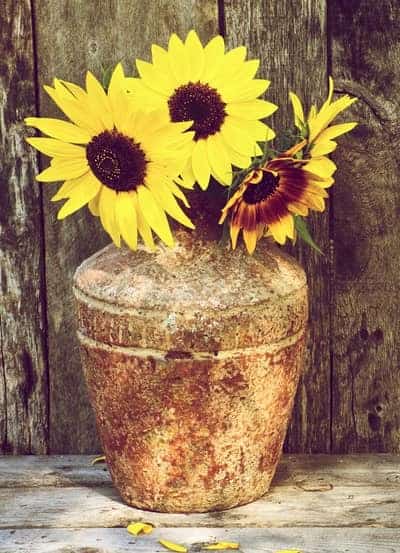I’ve always loved the bright colors of a sunflower field and how the plants seem to wake up each day to follow the light. So I wanted to see about growing sunflowers in pots to bring their cheeriness indoors.
To grow sunflowers in pots:
- Choose a dwarf sunflower variety, like Elf, Elegance, or Little Becka, which grow 16-36 inches tall.
- Plant seeds 1/2 inch deep in a 2-5 gallon pot filled with well-drained soil. Keep soil moist but not soggy. Seeds take 7-10 days to germinate.
- When seedlings are a 3-6 inches tall, transplant to individual pots, with 1 plant per 8 inch pot. Larger pots (15-inch diameter) can have up to 3 plants.
- Place the pot in full sun, 6-8 hours per day. Keep temperature between 75-85 degrees F.
It’s important to research which sunflower best suits your lifestyle as there are a ton of different varieties, or you might end up with a 15-foot-tall plant in your living room. For growing sunflowers in pots, I’ve listed different types of sunflowers and a more detailed explanation of how to care for your new companion. This article contains personally tested tips & tricks that’ll keep your sunflowers growing and glowing.
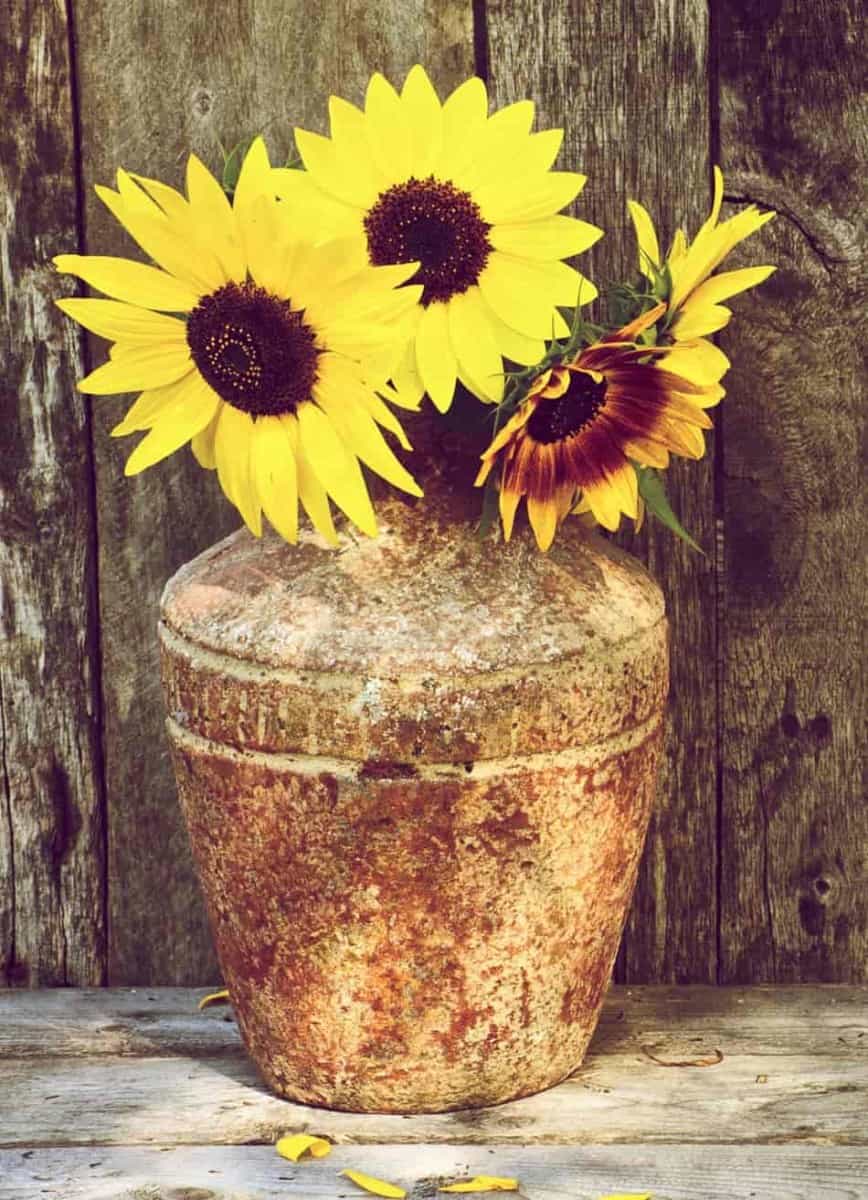
Sunflowers background
Sunflowers are pretty interesting plants, and knowing a bit about them & their biology will make it easier to grow them on your own.
First, sunflowers are composite flowers. That means that each giant flower is actually composed of lots of smaller flowers. So, a single big flower might actually contain hundreds of mini flowers.
Technically, sunflowers are members of the Asteraceae family, which is a huge family, containing asters, zinnias, daisies, and dandelions.
Since each flower head contains dozens or hundreds of mini flowers, the mini flowers mature at different times. So, you’ll notice that the outermost florets bloom & mature before the innermost florets.
Most sunflowers are annuals, meaning that they germinate, grow, flower, and produce seeds in a single year, but don’t regrow each year. So, like other annuals, they’re fast-growing.
The stems & leaves have tiny hairs that help reduce moisture loss.
If you want to grow sunflowers to attract bees, check out our complete guide to bee gardening.
Weird nerdy fact:Sunflower seeds grow in spirals based on the Fibonacci sequence. The Fibona–what? OK, a Fibonacci sequence is where each number is the sum of the previous two (1, 1, 2, 3, 5, 8, 13, 21, etc.).
Science, yo.
Can you grow sunflowers in a pot?
The short answer is yes, you can indeed grow sunflowers in a pot.
When growing sunflowers in a pot, first make sure there is a drainage system to accommodate your plant or take more care when watering as to not let the soil stay soggy.
You will want to choose a pot that is big enough for your sunflower to grow to its full size.
The size of the pot will determine how large your plant gets.
If you’re starting your plants indoors with the intention to move them to an outdoor setting, using a peat pot would be a great option because they are biodegradable.
Now that you have your pot, fill with soil until about two inches from rim.
Using store bought soil is a good option however sunflowers are tough and can grow in almost any kind of soil, so long as the soil is not frosty or watery.
Take a singular seed and using a method of one seed per pot, plant your seed into the soil.
When planting you should go about two-four inches deep into the soil, a good measurement tool to use is your thumb.
If you have a bit more space, you might want to learn how to grow sunflowers in raised beds. Check out our complete articles on:
Why you should only plant one sunflower seed per pot
The reason why we only plant one seed per pot is because sunflower seeds tend to branch off and can grow multiple flower heads from one seed.
Besides, when you’re growing sunflowers in pots, each sunflower plant can get pretty large–depending on the variety you’re growing.
Some varieties can grow up to 8 feet, and need a fairly extensive root system to support a plant that tall.
So, a 2-gallon pot can really only accommodate 1 full-grown sunflower. For larger sunflower varieties, a 5-gallon pot is better.
Each individual petal on a sunflower is actually an individual flower that has bloomed and joined other plants to create one “false flower”. This is called a composite flower.
If you’re moving your sunflowers outside, you should plant them 2 – 3 feet apart.
Starting & sprouting sunflower seeds
It’s good practice to water the soil immediately after you plant the seed and continue from there on as needed.
Remember to keep the soil moist and NOT SOGGY.
Once your plant begins to sprout, keep up with watering and try to maintain a schedule if possible for best results.
Keep in mind sunflowers need more water than your average house plant.
If you find the plant is not growing after the initial sprout or is not sprouting at all, you may need to add humidity so long as the issue isn’t dry soil.
You can add humidity in a few different ways like using a cloche. I used one that I was able to make at home.
Towards the end of the post is a guide on how to make a cloche for yourself if needed.
After the initial sprout:
- Your seed will take about 10-35 days to grow from seedling to plant.
- After that, your plant will take around 35-65 days to grow a bud.
- During the next 65-85 days is considered the blooming stage where you can enjoy your plants flower.
- Finally between 85-125 days is the prime time to harvest seeds and when your flower will reach the end of its life cycle.
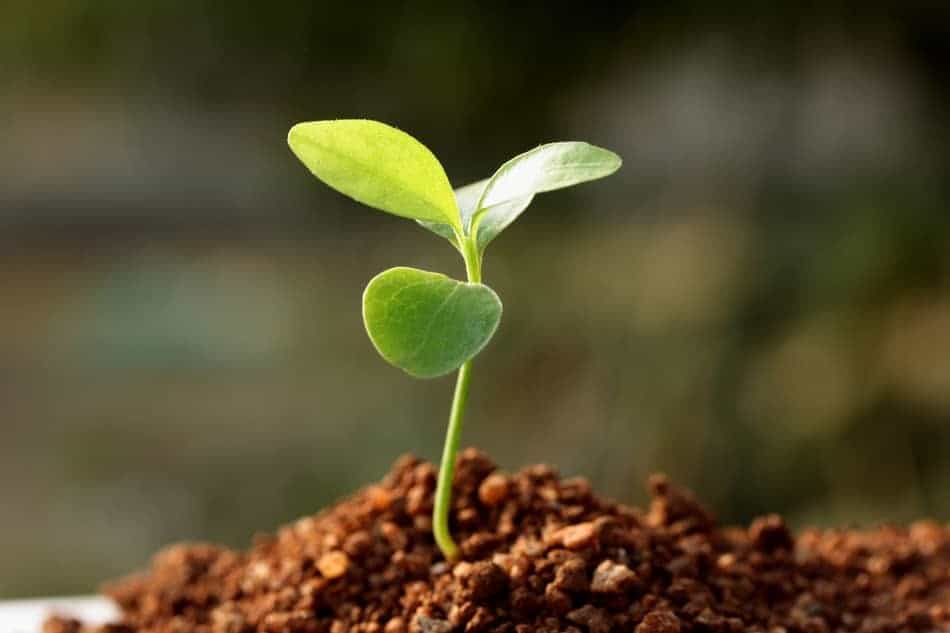
Where to put sunflower plant
Things to consider when looking for an area in your house to keep your plant are sun, space and safety.
You’ll want as much direct and full sunlight as possible and you will need to keep it in an area away from drafts, and other interference such as animals.
I speak from experience as one day my cat decided to eat all the sunflowers that I had grown over those months.
How to handle pets and common problems will be covered below.
Don’t get me wrong: I love my cat, but c’mon–let me grow some plants!
I had chosen a window that was taller versus wider because I wanted my sunflowers to be shone down on and not at.
So, I chose a south/west facing window because the sun is stronger in the afternoon, which again personally I think helped my plants to grow significantly.
Choosing your window will take some discretion however any window can be used as long as there is significant sunlight.
Best Sunflower varieties for pots
Sunflowers might all look the same at first glance, but there are around 70 different varieties.
All of which can be categorized within the Helianthus genus. Interestingly enough, a fun fact is that Helios can translate to sun, and anthos to the meaning of flower.
The sunflowers I am about to list are not specifically used for the purpose of growing edible sunflower seeds.
These varieties have beautiful flower heads and long stems which make them suitable for scenery and gardening.
If your intention is to grow a beautiful plant and try your hand at harvesting sunflower seeds I have created a list farther down that will include varieties that are more suitable for sunflower seed growing and harvesting.
When it comes to growing, sunflowers are either annual or perennial. Annual sunflowers need to be replanted each year, whereas perennials will regrow each season on their own. If you’re buying your seeds this will be labelled.
If you’re unsure about whether or not your flower is annual or perennial there are a few ways you can tell.
Annual sunflowers grow quickly, with a range of large and small seed heads; perennials on the other hand only have small seed heads which tend to grow slower.
Basically, annuals grow fast & die after 1 growing season, while perennials grow year after year.
|
Variety |
Pros |
Cons |
|---|---|---|
|
Elf |
Long growing period |
Smallest variety of the list |
|
Pacino |
24 inch maximum height |
Smaller petals |
|
Little Becka |
Coloured petals such as orange, red and yellow |
Never know which color will bloom |
|
Elegance |
Long stems, good for bouquets |
no edible seeds |
|
American Giant |
Iconic image of a sunflower |
Very large for a pot |
|
Super Snack |
Easy to crack and edible seeds |
Smaller Flower head |
|
Hopi black dye |
Larger shelled edible seeds |
needs a large pot |
|
Mammoth Russian |
Thin shelled edible seeds |
One of the largest varieties |
“Elf”
To start off our list of sunflowers, this variety is a perfect candidate for your first sunflower in a pot. The elf sunflower is one of the shorter varieties and only grows to a max height of just sixteen inches. The flower itself can bloom up to four inches. Despite its small stature and height, this flower closely resembles the well known image of the golden sunflower with its yellow petals. This flower can grow for long periods of time and in smaller spaces which makes it a perfect trial sized plant.
“Pacino”
Next in line, and very similar to the elf variety is the small but beautiful Pacino sunflower. Besides having a cute name, this flower is adorned with short, bright yellow petals on larger flower heads. This flower only grows to a maximum height of around twenty-four inches, not far off from the Elf variety but with a little extra something. Hoo-ah!
“Little Becka”
To add some colour into our list of varieties, I have chosen to add the little Becka. It is a small plant that should not be ignored as it can grow some of the deepest red and orange hues imaginable. Little Becka is as mentioned before, an orange and red hued sunflower that can even presents itself with a round yellow halo of colour within the petals outward formation. The little Becka can grow to a height of three feet which makes this dwarf sunflower a suitable option for both indoor and outdoor settings.
“Elegance”
The last small type variety of sunflower I will mention is Elegance. The name alone is memorable enough to remember when you are out shopping at the local garden depot. Elegance is a smaller sunflower that is bursting with colour. The plant itself is perfect for pots because it only grows around twenty – thirty inches high. The elegance plant is also a suitable choice for bouquets due to the long stems and multiple flower heads.
“American Giant”
The last sunflower worth mentioning is the almighty American giant. This sunflower is the generic image that pops into everyone’s mind when they think sunflower. This beast of a flower is among the tallest varieties of sunflowers and can grow up to a sizable fourteen feet high with a flower head that is a foot across.
These sunflowers will be more challenging to grow indoors and will ultimately depend on the gardener, the pot they are in (size wise) and the sunlight that is available to them. These flowers are great to start indoors and transfer outside, either in a garden or to make a beautiful border around a yard.
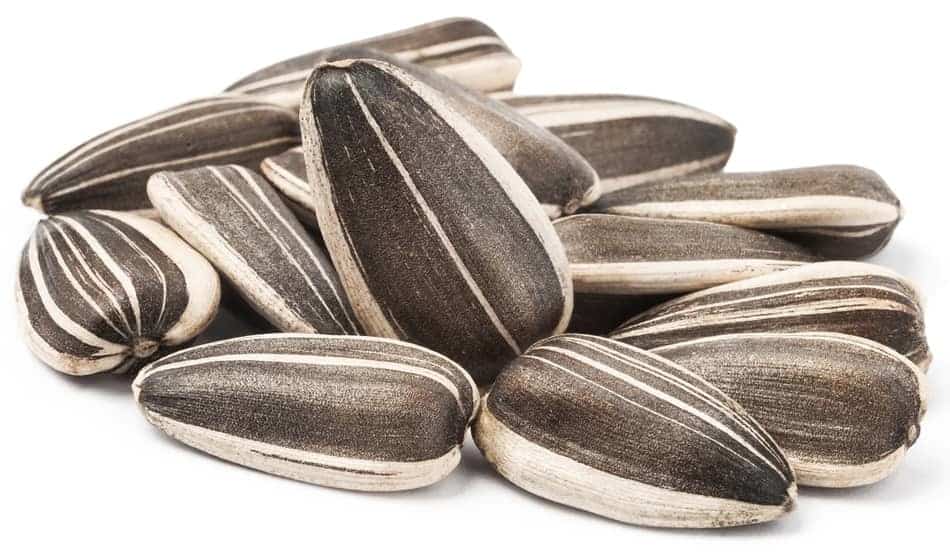
Types of sunflowers with edible seeds
“Super snack”
As the name suggests, this small plant can pack a punch in the form of snacks. Growing only to a maximum height of around five feet, this smaller sunflower grows less flower heads but more seeds that are easy to crack.
“Hopi Black Dye”
This sunflower is a taller variety and ancient, which means it has been used for thousands of years for this purpose. The Hopi sunflower was first discovered, used and eaten by the Hopi Native American tribes and hasn’t changed much since.
“Mammoth Russian”
Arguably one of the most “mammoth” sunflowers, this flower can grow up to heights ranging from twelve to fifteen feet tall. This plant is the classic image of a sunflower plant which produces classic style, thin shelled seeds.
Ironically, while sunflowers are actually native to North America, 53% of the world’s sunflower seeds are grown in Russia & Ukraine.
How to Grow Sunflowers: Tips & Tricks
So, if you’re having trouble maintaining soil moistness, use your fingers to feel the first layer of the soil; if it is dry and crumbly you should add water.
If the soil feels wet and dampened, you may be over watering or need to check your drainage system.
Poking holes in the bottom of your container and using a lid to catch water underneath is the easiest and cheapest way to accommodate a pot without holes.
It is important not to over water because sunflowers, like all plants are easily susceptible to fungal wilting.
Fungal wilting would make the sunflowers stem and leaves start to turn black or dark brown.
Diseases and other fungi are covered further down in this article.
If your plant is having difficulty standing, tie a small stick to the plant, which can be stuck in the soil next to it.
This will help the stalk to grow straight and have something to lean on.
If you find your animals interfering with your plant, try using plant holders to raise the plant off the ground.
Sunflowers need lots of nutrients and fertilizers can get expensive. A great and cheap alternative to use is right in your fridge.
The next time you buy eggs, save the shells in the carton and use the shells as fertilizer for your plant!
Simply smash the egg shells into tiny pieces and sprinkle onto the soil.
How to harvest sunflowers
Should you deadhead sunflowers?
To keep any plant or flower looking its freshest and healthiest, you will need to regularly deadhead and trim your plants.
Deadheading simply means to –remove dead flower heads and leaves from plants.
You’ll be able to tell that a flower head is dead when the flower head is wilted, faded, dried out or if the natural color changes to dark brown/black.
It’s vital to keep up care with deadheading because if the deadheads are left on the plant, there will be nowhere for new bulbs to grow from.
Another note worthy fact is if you let your plants grow wild and unkempt or too close together in spacing, the plants will compete for sunlight resulting in less flower heads that will be able to grow.
When deadheading you will want to leave the stem and remaining leaves in tact for the next sprouting bud.
Leaving on sick or dried out leaves can harm your plant by spreading bacteria.
The difference between deadheading regular flowers and sunflowers
When you’re dead heading other flowers, once the deadhead is cut, it can be thrown away.
However when a deadhead is cut from a specific type of sunflower, it is only the beginning of a unique process that is special only to these types of plants.
The deadhead will begin a drying process in which seeds will dry out and begin to take form within matured and dried out sunflower heads.
These seeds are edible, tasty and widely sold across the world.
There is more involved in the cooking process of sunflower seeds once the seeds are removed.
How to gather sunflower seeds
To gather your seeds, look at the flower bulbs or heads towards the end of their life span–around 85-120 days after sprouting.
If the petals are falling off and they are already drying out that means they are ready.
Cut away the sunflower head a few inches below the actual flower.
A great way to store deadheads while waiting for the drying process to finish is to collect and place them into paper bags that can be stored in a cool, dry and dark area.
The paper bag will help to absorb any moisture left in the flower head.
Once the heads are dried you can pull out and remove the seeds.
The amount of seeds that are harvested will depend on the type of sunflower being used and the size of the flower.
Once you’ve harvested your seeds don’t throw away the flower head just yet!
Sunflower heads that have been harvested make great scouring pads and can be used for scrubbing on tough cleaning jobs.
Common problems growing sunflowers in pots
If you’ve noticed your sunflower is not blooming, growing or sprouting properly there can be a few possibilities as to why that is.
Check that the soil is maintained and that the flower and the plant does not look distressed (discolored, wilting).
Sunflower Diseases
Sunflowers are hardy plants, but the one thing that can cause them most harm is over watering.
If the soil is wet you should try to change the soil or pot arrangement. When sunflowers are over watered they’re more susceptible to diseases such as root rot and different fungi.
These fungi and root rot can change the color of your plant to a yellow or a dark brown/black color.
If you notice yellow spots on leaves, this can also be a sign of a sick plant.
Root rot can kill sunflowers very quickly if not taken care of.
The best solution is to transfer your plant into new soil and water less.
Sunflower Pests
Indoor sunflowers won’t have many pest issues or threats.
The biggest threat may be your closest companion, your dog or cat.
My cat ate all my sunflower heads the day they finally bloomed and despite being strong, they couldn’t recover.
To avoid any issues with animals make sure your plant is inaccessible for them.
If you can’t do that, there are alternative solutions.
Now if your plant is in a greenroom or outside, then beetles like the sunflower beetle and moths can be a concern.
An easy solution for all these pests is to mix one tablespoon of dish washing soap with one gallon of water and then spray the mixture onto your plant.
The water will dilute the chemicals in the soap so it won’t hurt your plant, but the soap will be enough of a deterrent for animals and bugs.
Humidity and how to make a sunflower cloche
Assuming all those things are okay and in check, humidity may be the contributing factor as to why your plant is not thriving.
Sunflowers grow best in hot and humid climates and so you should try to imitate that setting for your plant.
If you have access to humidifiers or a suitable greenhouse space than you should always try to use those options first.
If you’re looking for cheaper alternatives, there is the option of making your own sunflower cloche.
I used this in helping my own sunflowers to grow and I found it very effective.
Take a larger soda bottle or any plastic bottle, milk jug etc.
Cut the container right through the middle in one even horizontal line so that you end up with two halves of your container.
Using the side of the container with has the drinking hole, place your container over your plant covering the surrounding soil where your plant or sprout is.
That’s it!
Now your container should contain some humidity and keep it trapped closer to the soil of your plant.
The drinking hole will help to draw air in for your plant and keep a regular flow of oxygen.
While the bottom half can be used for humidity, it will not give your plant a continuous flow of oxygen.
For this reason I’d recommend using the top portion.
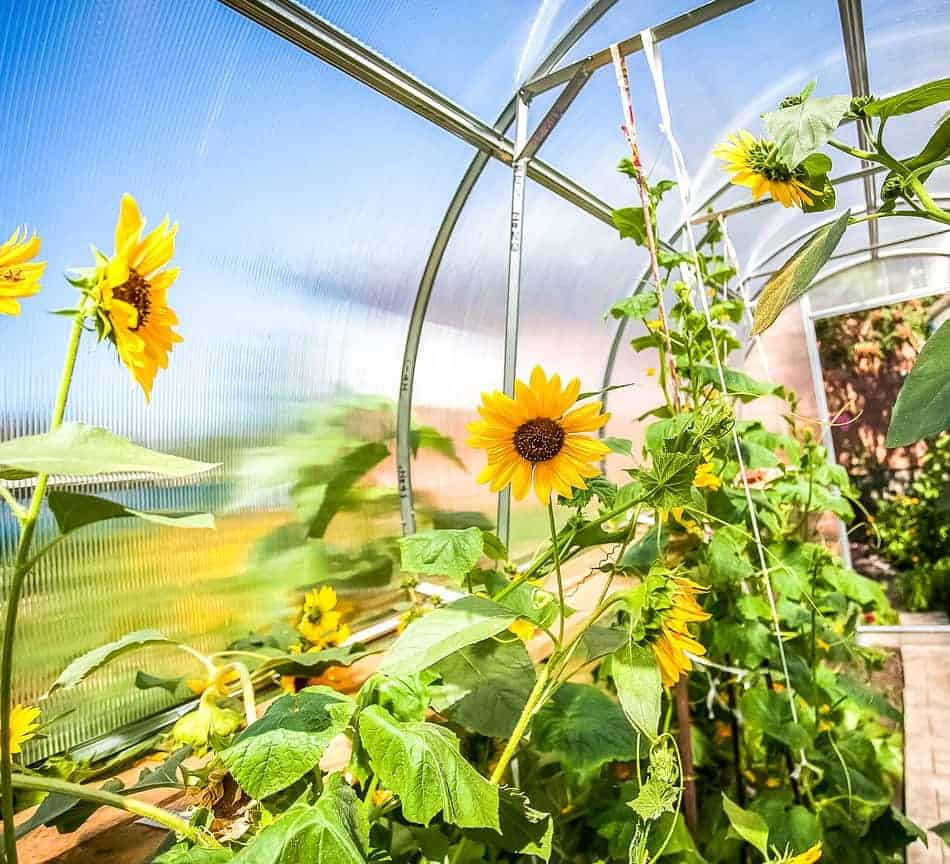
Related questions
Do sunflowers need lots of sun?
Absolutely! Sunflowers require full and direct sunlight which translates to between six to eight hours each day if possible.
How long does it take to grow a sunflower?
Sunflowers vary from plant to plant with how long they take to grow. For example, sunflowers typically take 7-10 days before they start to sprout. Then up to 2 weeks for the first flowers or leaves to appear. Sunflowers can grow for long periods of time, usually from 80 to 120 days in length.
What time of year is the best time to plant sunflowers?
Sunflowers can be planted at any time of the year if they are being kept indoors. Frost and cold from the outside can still be a harmful factor for indoor plants. So, the best time to plant sunflowers between early spring into late summer. This is the time when the sun will be shining its strongest and brightest, which is what sunflowers need.

